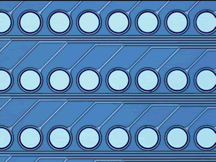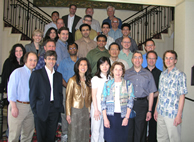|
|
 |
Artificial
Retina Project Collaborators
An
effort spanning 6 DOE national laboratories, 4 universities, and
private industry
Multidisciplinary
groups across the United States are using a highly focused and
coordinated approach to develop a dramatically improved retinal
prosthetic device to restore sight to the blind. The Doheny Eye
Institute, Oak Ridge National Laboratory, and Second Sight lead
the collaborative effort through an executive committee.
|
|
Doheny
Eye Institute at the University of Southern California Los
Angeles
Provides medical direction and performs
preclinical and clinical testing of the electrode array
implants. Leads the Artificial Retina Project.
|
|
|
Second
Sight Medical Products Inc.
Manufactured the Model 1 and Model 2 devices
(the latter with DOE contributions) and will integrate DOE
technologies into a Model 3 design. SSMP will be responsible
for integration and production of devices under FDA regulations,
performance of clinical trials, and eventual commercial
distribution to patients.
|
|
|
Argonne
National Laboratory
Performs packaging and hermetic- seal research
to protect the prosthetic device from the salty eye environment,
using their R&D 100 award-winning ultrananocrystaline
diamond technology.
ANL Laboratory
Spotlight  |
|
|
Brookhaven National Laboratory
Performs neuroscience imaging studies of
the Model 1 retinal prosthesis.
|
|
|
Lawrence
Livermore National Laboratory
Uses micro-fabrication technology to develop
thin, flexible neural electrode arrays that conform to the
retina's curved shape. LLNL also uses advanced packaging
technology and system-level integration to interconnect
the electronics package and the thin film electrode array.
LLNL Laboratory
Spotlight 
|
|
|
Los
Alamos National Laboratory
Performs imaging and modeling of retinal
function and develops advanced optical imaging techniques.
These contributions will provide a better understanding
of how the prosthesis works by mapping the interaction between
the brain and retina.
|
|
|
North
Carolina State University
Performs electromagnetic and thermal modeling
of the device to help determine how much energy can be used
to stimulate the remaining nondiseased cells.
|
|
|
Oak
Ridge National Laboratory
Measures the effect of increasing the number
of electrodes on the quality of the electrical signals used
to stimulate the surviving neural cells in the retina.
|
|
|
Sandia
National Laboratories
Develops microelectromechanical (MEMS) devices
and high-voltage subsystems for advanced implant designs.
These include micro-tools, electronics packaging, and analog-specific
integrated circuits (ASIC's) to allow high-density interconnects
and electrode arrays.
|
|
|
University
of California, Santa Cruz
Performs bidirectional telemetry for wireless
communication and chip design for stimulating the electrode
array.
|
|
|
California
Institute of Technology
Performs real time image processing of miniature
camera output and provides optimization of visual perception
for the Artificial Retina Project.
|
|












